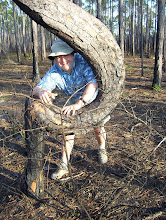On the next day following the State Archaeologist's visit, I finally met Dr. Julie Bartley, professor of Geology at the University of West Georgia in Carrollton. Dr. Bartley will be leading the March workshop on Geology in the Hill Country, and was visiting the area to scope out possible outcrops to visit. It was great to get to "talk geology" with someone again, swapping rock types, mineralogical compositions, and geological mapping strategies. After looking over an old and less than reliable geologic map of the area (the only one in print), we settled on exploring at Cochran Mill Park. Three Montessori students joined Dr. Bartley and myself for a ride out to Cochran Mill Nature Center.
Our first stop was right at the entrance to the nature center, where we checked out some enormous granite boulders. Dr. Bartley explained how granites weather into soil, as we scanned the rock face for white feldspar crystals and gray-green lichens (best saved for another day). The photo on the top was taken there; I will save an image of the boulders themselves for our March trip, since this will undoubtedly be one of the places we visit then.
We hiked down the trail from the nature center to the granite outcrops along Bear Creek. On the way, Dr. Bartley showed us how angular the sand grains were along the trail, angular because that is the shape of the feldspar crystals contained in the granite. Then, onto the outcrop (photo on the bottom), scanning the rock for mineral composition, looking at jointing structures (cracks) in the rock, and then searching for a contact with the adjacent rock, a metamorphic gneiss. We found the contact at last, down by the water's edge. The creek flows along the place where the granitic magma intruded into the country rock (no allusions to a former Chatt Hills mayoral candidate intended), a gneiss or perhaps a schist. We found evidence of the other rock type on the other side of the stream, but the water was too fast flowing and deep to allow us to cross. The contact was entirely hands-off. Investigation of those rocks will have to await another day, perhaps a weekend in February, if Dr. Bartley's schedule permits. Considering that the rock is already a few hundred million years old, I suspect it will still be there when we return.




No comments:
Post a Comment